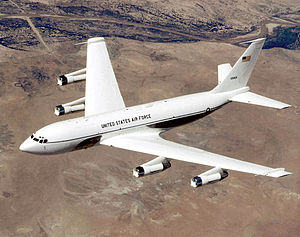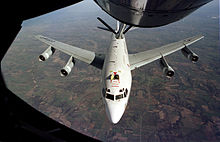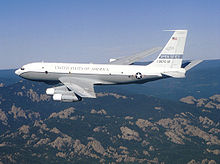Boeing C-135
| Boeing C-135 Stratolifter | |
|---|---|
 A USAF Boeing C-135C "Speckled Trout" |
|
| Type: | Military transporter |
| Design country: | |
| Manufacturer: | |
| First flight: |
17th August 1956 |
| Commissioning: |
June 1957 |
| Production time: |
1954 to 1965 |
| Number of pieces: |
803 |
The Boeing C-135 Stratotanker Lifter is a military transport aircraft of the US Air Force (USAF) , the Boeing in the late 1950s by the KC-135 was derived.
In a broader sense, C-135 is the name for the entire series, which includes a large number of variants. Only the models KC-135A and -B, RC-135A, -B , and C-135A, -B and -F were newly built . All other versions - including the EC-135 , OC-135, WC-135 and dozens of sub-types - have arisen through retrofitting over the years.
C-135 series
The basic versions belong to the C-135 family:
- C-135: transport aircraft; 45 units built between 1961 and 1962, see below
- EC-135: Electronic Equipment; from 1961 on from converted C- and KC-135
- KC-135: tanker aircraft ; 761 units built between 1956 and 1962, including 12 for France
- OC-135: observation aircraft; 3 pieces from 1992–1996 from converted WC-135s and in use within the framework of the Treaty on Open Skies .
- RC-135: reconnaissance aircraft ; older versions were made from converted C- and KC-135s, 14 new units were built between 1964 and 1965, and Great Britain procured three machines to replace the Nimrod R1 .
- TC-135: Training aircraft for the RC-135
- VC-135: VIP Transporter; 7 pieces were made from converted C-135s between 1967 and 1975
- WC-135 Constant Phoenix: weather reconnaissance aircraft; 10 of the converted C- and KC-135s were built in 1965, in 2011 two aircraft were still in use, the base was Offutt Air Force Base in the US state of Nebraska. In April 1986 also used to determine radioactivity in Europe due to the Chernobyl disaster . Used in March 2011 for air sampling and collection operations in Japan during the Fukushima nuclear disaster . The last remaining WC-135 was used in 2016 as part of the nuclear weapons tests of the North Korean Nuclear Weapons Program.
C-135 transporter
origin
At the end of the 1950s, the Military Air Transport Service (MATS), the air transport command of the US Air Force, tried to modernize its transport fleet. In 1960 this consisted mainly of propeller-driven C-124 Globemaster II and C-133 Cargomaster , while all other main commands had already switched to jets . The Air Force was faced with the decision to either purchase a freighter variant of an existing model at short notice or a newly developed uncompromising military transporter with a correspondingly longer waiting time. The USAF initially chose the fast route. Douglas offered a freight version of its DC-8 , with turbo engines and a foldable rear for easy loading. Boeing proposed a similar design based on its successful KC-135 Stratotanker tanker .
C-135A
In May 1960, the approved US Congress the procurement of 50 Boeing transport aircraft with the designation C-135 Stratotanker lifter for a total of 169 million US dollars . For reasons of cost, both the modern turbofans were omitted in favor of cheaper J57 turbojet engines and the hatchback. The only major differences to the KC-135A were the lack of a tank system and a reinforced floor in the cargo deck. So the dimensions of the cargo space remained the same with a width of 3.28 m and a height of 2.11 m. With no access to the refueling compartment, eight 463L pallets fit in, two more than the Stratotanker. The maximum payload was 41.1 tons, alternatively up to 126 soldiers. A cargo loading system with a winch and rails on the ceiling made loading easier through the 2 x 3 meter cargo door on the side. However, these conveyor rails reduced the usable height to 1.73 m.
In order to be able to receive the new transporter as quickly as possible, the MATS had three KC-135A already under construction converted to C-135A. The first flight of the first machine with the USAF serial number 60-0356 took place on May 19, 1961, it was available to the Air Force from June 8, 1961.
The first real C-135A (Boeing model number 717-157) with the serial number 61-0369 flew for the first time on June 23, 1961. The Luftwaffe took over the first copy on August 12 of the same year for the 18th air transport squadron of the 1611th air transport wing of the MATS at McGuire Air Force Base , New Jersey . Boeing delivered a total of 15 newly built C-135A plus three converted ones.
The three Stratolifters created from KC-135 were converted for reconnaissance purposes in 1962 and in the mid-1970s they were converted into tanker aircraft KC-135A and finally KC-135R. Most of the remaining C-135A were converted to EC-135N ARIA in 1966 as a measurement and communication platform to support NASA's Apollo moon missions . At least three EC-135Ns were called C-135Ns after the electronics were removed in 1979 . Further use of the C-135A included testing and transportation of air force commanders. Some received more modern TF33 engines and the designation C-135E in the 1980s .
C-135B
Boeing produced 30 of the originally planned 50 C-135s as the improved version C-135B (Boeing model number 717-158). They had more powerful Pratt & Whitney TF33-P-5 turbofan engines with 71 kN power and thrust reverser instead of the J57-P-59W with 50 kN in the C-135A. Other changes included an enlarged horizontal stabilizer and a revised interior (kitchen, toilets, ventilation, noise insulation). The first flight of the B-model took place on December 20, 1961, the handover to the Air Force on March 1, 1962. MATS took over the 30th C-135B and the last of a total of 45 Stratolifters in autumn 1962. As early as 1965, the B version, as the successor C-141 Starlifter became available in increasing numbers. The USAF then used the Stratolifters for a number of special purposes, including telemetry (C-135B TRIA, EC-135B ARIA), weather reconnaissance (WC-135B), VIP military transport (VC-135B), reconnaissance (RC-135M) and Observation under the Open Skies Contract (OC-135B).
A C-135B (61-2669) was first modified to a WC-135B in 1965, dismantled to a C-135B in 1972 and converted into a test platform for cockpit avionics in 1974 under the name C-135C Speckled Trout . Secondly, it served the promotion of USAF commanders. It flew for the last time on January 13, 2006, was decommissioned on February 10 after 31,000 flight hours and has since been exhibited in the Museum of the Air Force Flight Test Center at Edwards Air Force Base .
C-135F
The C-135F tanker and transport aircraft, built for France from 1963, is technically more closely related to the KC-135A than to the C-135 freighter. Since the transport role for France was on a par with refueling, it was given the designation C-135F and not KC-135F. They have been called the C-135FR since a modernization in the 1980s . See Boeing KC-135 # C-135F - Tanker for France .
C-135K
The Luftwaffe designated a single aircraft in 1996 as the C-135K . It is a former EC-135K and original KC-135A with their special electronic equipment removed. The machine with the serial number 59-1518 served as a VIP aircraft at Hickam Air Force Base , Hawaii , from late 1996 until the USAF retired it in March 2003.
commitment
The Luftwaffe did not lose sight of the procurement of a newly developed freighter and in March 1961 decided to build the C-141 Starlifter. Therefore, the Stratolifter was only used as a transporter for a few years. However, it was not suitable for bulky goods because of the loading opening on the side, nor for parachute jumps. In addition, the A-model could only land on long lanes when loaded due to the lack of thrust reversal, so that the transported cargo often had to be brought to the operational area by road. The speed advantage of the jet compared to its propeller-driven predecessors was put into perspective.
In mid-September 1961, the MATS used the C-135 for the first time to move troops of the 101st Airborne Division of the US Army to Turkey. A large number of transport missions followed, in which the C-135 set some records for non-stop distances and flight times. For example, on January 11, 1962, when a C-135A covered the 8,208 kilometers from Fort Lewis , Washington to Rhein-Main Air Base in ten hours and ten minutes. From 1965 the C-141 began to replace the Stratolifter in air transport. The Luftwaffe gradually converted them for various other tasks. Seven stratolifters were lost in accidents, killing over 100 people. Around half of the machines built were still in service at the beginning of 2007, but none of them as normal transport aircraft.
production
Acceptance of the C-135 by the USAF:
| version | 1957 | 1958 | 1959 | 1960 | 1961 | 1962 | 1963 | 1964 | 1965 | 1966 | 1967 | TOTAL |
|---|---|---|---|---|---|---|---|---|---|---|---|---|
| KC-135A | 37 | 158 | 152 | 87 | 60 | 76 | 96 | 66 | 732 | |||
| C-135A | 14th | 1 | 15th | |||||||||
| C-135B | 30th | 30th | ||||||||||
| EC-135A (ACPS) | 3 | 1 | 4th | |||||||||
| EC-135C (PACCS) | 14th | 14th | ||||||||||
| EC-135C (NEACP) | 3 | 3 | ||||||||||
| RC-135C | 10 | 10 | ||||||||||
| C-135F | 12 | 12 | ||||||||||
| TOTAL | 37 | 158 | 152 | 87 | 74 | 107 | 96 | 92 | 6th | 1 | 10 | 820 |
Incidents
A total of 76 Boeing C-135 family aircraft were lost in crashes or accidents.
| Aircraft type | Number of accidents | Death toll |
|---|---|---|
| KC-135A | 56 | 350 |
| KC-135E | 2 | 6th |
| KC-135P | 1 | 5 |
| KC-135R | 2 | 6th |
| KC-135Q | 2 | 5 |
| C-135A | 1 | 84 |
| C-135B | 2 | 87 |
| C-135F | 1 | 4th |
| EC-135C | 1 | 0 |
| EC-135J | 1 | 0 |
| EC-135K | 1 | 20th |
| EC-135N | 1 | 21st |
| EC-135P | 1 | 0 |
| RC-135E | 1 | 19th |
| RC-135S | 1 | 0 |
| RC-135T | 1 | 3 |
| VC-135A | 1 | 0 |
As of January 1, 2010
Technical specifications
| Parameter | C-135B data |
|---|---|
| crew | 4 (pilot, copilot, navigator, loadmaster) |
| length | 41.5 m |
| span | 39.9 m |
| height | 12.7 m |
| Wing area | 226 m² |
| Empty mass | 46.4 t |
| Max. Payload | 40.4 t freight or 126 soldiers with equipment or 44 stretchers for MedEvac missions |
| Max. Takeoff mass | 124.7 t |
| drive | Four Pratt & Whitney TF33-P-5 turbofans with 71.4 kN thrust each |
| Top speed | 980 km / h |
| Summit height | 15,000 m |
| Max. Range | 12,000 km |
literature
- Don Logan: The Boeing C-135 Series. Stratotanker, Stratolifter and other Variants. Schiffer Publishing, Atglen PA 1998 ISBN 0-7643-0286-8 ( Schiffer Military History ).
- Robert S. Hopkins: Boeing KC-135 Stratotanker. More than just a tanker. Aerofax, Earl Shilton 1997, ISBN 1-85780-069-9 .
Web links
Individual evidence
- ^ Christopher Hoctor: Voices from an Old Warrior: Why KC-135 Safety Matters . University of Missouri, Columbia, 2014, 2nd Edition, online PDF 8.5 MB ( Memento from March 4, 2016 in the Internet Archive )
- ^ Eielson Air Force Base gets radiation-detecting jet in response to Japan's nuclear crisis Robert F. Dorr: Constant Phoenix: After Decades of Service, a Little Recognition at Last. April 9, 2011, accessed December 1, 2019 .
- ↑ Factsheet of the US Air Force. May 27, 2005, accessed December 1, 2019 .
- ↑ CONSTANT PHOENIX WC-135W globalsecurity.org
- ↑ US boosts radiation-sniffing system msnbc.msn.com; Pentagon Sends Radiation Detection Plane to Monitor Japan's Nuclear Crisis bloomberg.com, accessed March 18, 2011
- ^ The Washington Post : This is the Air Force radiation sniffer plane deploying after North Korea's nuclear test , accessed January 26, 2016
- ↑ Statistical Digest of the USAF 1957, pp. 97 f .; 1958, p. 72 f .; 1959, p. 68 f .; 1960, p. 62 f .; 1961, p. 70 f .; 1962, p. 72 f .; 1963, p. 71 f .; 1964, p. 58 f .; 1965, pp. 60 f .; 1966, p. 115 f .; 1967, p. 122 f.


